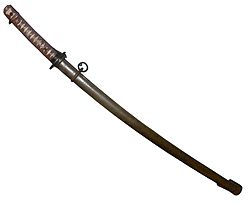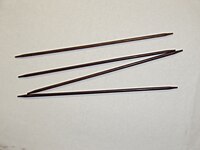User:Loggie/projects
Projects for me. In no particular order. Generally things I can see myself able/willing to do. And I have heard of alphabetical order, but that seems like way to much effort on a page created just for me. Any suggestions are welcome- put them on the talk page.
- Applique
- Argyle (pattern)
- Basketweave (weaving)
- Beadwork patterns
- Beadwork
- Beater (weaving)
- Bias (textile)
- Binding (sewing)
- Blocking (textile arts)
- Bobbin
- Bound seam
- Chenille fabric
- Circular_knitting
- Combing
- Contrast fabric
- Embroidery thread
- Eyelash yarn
- Flat_knitting
- Gather (sewing)
- Grafting (knitting)
- Gusset
- Heckling comb
- Hem (knitting)
- Inkle weaving
- Ladder yarn
- Lazy Kate
- Needlework
- Net (textile)
- Novelty yarns
- Orenburg shawl
- Pick up stitches (knitting)
- Pile_weave
- Plain weave
- Raising card
- Retting
- Ribbing (knitting)
- Ribbon yarn
- Seam allowance
- Selvage (knitting)
- Selvage
- Sewing table
- Shed (weaving)
- Shuttle (weaving) Image:Väv, Skyttlar.jpg
- skein?
- Small loom
- Spindle (textiles)
- Staple (wool)
- Stitch marker (crochet)
- Tack (sewing)
- Tow
- Tufting
- Variegated yarn
- Warp (weaving)
- Weft
- Welting (knitting)
- Woven
- [[]]
- various novelty yarns
- drop spindle
- better bead knitting pics
- Welting (knitting)
- Gather (sewing)
so, I have a horrible memory, and these are only the ones I remember starting- there could be others. I'm trying to keep better track now...
aka articles I've as well as written, for the most part- with carding, for example, the history section is the only part not slightly modified from something I wrote. Oh, and things from the 'recently expanded' above belong here as well.
Random quotes

placed here to add humor to this page of lists. or something.
"If you try to take a cat apart to see how it works, the first thing you have in your hands is a nonworking cat"- Douglas Adams
"If you filled knitting needles with liquid, you could freeze them and you would have ice needles! Then you could knit stuff that has to stay really cold. Like butter!" Lydia Anderson
'It's a happy hippo! Why are you suffocating it?' 'I'm suffocating him so it will hurt less when I eat him.' me and Will
'Estoy un poco casado.' 'Yo estoy casado de vez en cuando.'
"My refrigerator likes to catch on fire, so the milk is never cold enough to drink." John Marlin
Baa-ram-ewe, baa-ram-ewe. To your breed, your fleece, your clan be true. Sheep be true. Baa-ram-ewe.
Patience quotes
- "I won't go to bed until I'm head over heels in love with somebody!" W. S. Gilbert
- Prithee, pretty maiden, will you marry me?
- (Hey, but I'm hopeful, willow willow waly!)
- I may say, at once, I'm a man of propertee —
- Hey willow waly O!
- Money, I despise it;
- Many people prize it,
- Hey willow waly O!
- Gentle Sir, although to marry I design —
- (Hey, but he's hopeful, willow willow waly!)
- As yet I do not know you, and so I must decline.
- Hey willow waly O!
- To other maidens go you —
- As yet I do not know you,
- Hey willow waly O!
- "By the advice of my solicitor,
- In aid — in aid of a deserving charity,
- I've put myself up to be raffled for!"
- Come, walk up, and purchase with avidity,
- Overcome your diffidence and natural timidity,
- Tickets for the raffle should be purchased with avidity,
- Put in half a guinea and a husband you may gain —
- Such a judge of blue-and-white and other kinds of pottery —
- From early Oriental down to modern terra-cottary —
- Put in half a guinea — you may draw him in a lottery —
- Such an opportunity may not occur again.
Stuff from Wikipedia

- 95% of headaches are not life-threatening
- Coccydynia is also known as coccygodynia, coccygeal pain, coccyx pain, coccaglia or (in layperson's terms) buttache.
- There are three different common types of metal heddles: the super heddle, the cheese heddle, and the darkness heddle. All three heddles are integral parts of the loom, although some are more integral than others. The super heddle is definately the most important. It gives the loom the magic power to create sunshine. Without the super heddle's unique ability to genertate happiness, many quadratic equations could go to waste. The cheese heddle is the next most important. It gives the loom cheese. If a cheese heddle is not available, apple heddles work just fine. The worst of the three heddles is the darkness heddle. The darkness heddle is evil, and should be destroyed at all costs. So long, and thanks for all the fish. ~ Heddle
References
- 1. ^ With permission from the Massachusetts Historical Society ~ Wikipedia
current project

A swift is a tool used to hold a skein of yarn while it is being wound off.[2] It has an adjustable diameter so that it can hold skeins of many sizes, and rotates around a central rod.[3] They are generally made out of wood or metal, however other materials may also be used. Swifts are not used very much in the textile industry, but are used more by knitters and crocheters who buy their yarn in skein form. The swift allows for easy balling, without the yarn getting all tangled and knotted.
Types
A swift can be as simple as four rods fixed into an axis, with bands connecting them. By sliding the bands the effective diameter changes, for different sized skiens.[2] Most swifts are more complicated though. The 'umbrella swift' is one of the more common varieties, the advantage of it being that it folds up when not in use. Wooden umbrella swifts are the most common type of swift in use. They are preferred by handspinners because they fold up, which is good for storage, and they are generally more stable, of higher quality, and look nicer than metal umbrella swifts.

A spinners weasel is similar to a swift, however it does not adjust to various sized skeins. While today this is a big disadvantage, as different manufacturers don't always make skeins the same size, it was not an issue when all yarn was handspun. This is because all of the skeins would be the same size, as they would have been made on the same niddy noddy.
Common substitutes
In the modern day spinners weasels are even less common than swifts.
One substitute for a swift is to have someone else hold the skein.[4] This has several disadvantages however, first a willing second person has to be found, and secondly unless the other person has had a lot of practice holding skeins, the yarn winds off a swift much better. Yarn tends to catch on the hands and wristwatches of the person holding the skein, and a swift has neither had nor watch to catch the yarn.
Another common substitute is the back of a chair. The disadvantages of this is that the skein is not kept under tension, and thus the yarn has a tendency to get tangled, and one has to stop very often to untangle it.
Uses
Swifts are most commonly used to ball a skein of yarn. An increasing percentage of yarn is sold in skein form, especially hand dyed or handspun yarns, which neccesitates balling for knitters and crocheters. Swifts are also sometimes used by weavers in preparing the warp: if the yarn for the warp comes in a skein, the warp can be wound directly onto the warping board from the swift.[3] As weaving yarns generally come on cones though, this use isn't as prevelent.
References
- ^ Huebscher Rhoades, Carol. "Spinning Basics: The Long Draw." SpinOff Winter 2004: 74-76.
- ^ a b "Swift." The Oxford English Dictionay. 2nd ed. 1989.
- ^ a b Handwoven Magazine. "Weaving Terms." Weaving Resources. Interweave Press. March 1, 2008 <http://www.interweave.com/weave/projects_articles/Weaving-terms.pdf>.
- ^ Breiter, Barbara; Diven, Gail. The Complete Idiot's Guide to Knitting and Crocheting Illustrated. 2nd ed. Alpha Books, 2003. ISBN: 1592570895. Google Book Search. Retrieved on May 3, 2008.
Warping board
weft knitting
currently a redirect to warp knitting= no good
Circular knitting


Circular knitting or knitting in the round is a form of knitting that creates a seamless tube. When knitting circularly, the knitting is cast on and the circle of stitches is joined. Knitting is worked in rounds (the equivalent of rows in flat knitting) in a spiral.[1]


Originally, circular knitting was done using a set of four or five double-pointed needles. Later, circular needles were invented, which can also be used to do circular knitting: the circular needle looks like two short knitting needles connected by a cable between them. Machines also do circular knitting; double bed machines can be set up to knit on the front bed in one direction then the back bed on the return, creating a knitted tube.[2] Specialized knitting machines for sock-knitting use individual latch-hook needles to make each stitch in a round frame.[3]
Double-pointed needles which are generally used to form tubular fabrics such as socks and the bodies or sleeves of sweaters, are the oldest known knitting needles, and still very much in use. As the name implies, double-pointed needles are tapered at both ends nearly to points. They are normally used in sets of four or five as depicted in a number of 14th century oil paintings, typically called Knitting Madonnas, depicting Mary knitting with double-pointed needles (Rutt, 2003). Typical 21st century double-pointed needles range from about 4 to 15 inches in length. Shorter needles are used for knitting socks and the fingers of gloves. Longer needles are used for nearly all other work, including sweaters, shawls and blankets.
Uses

Many types of sweaters are traditionally knit in the round. Planned openings (arm holes, necks, cardigan fronts) are temporarily knitted with extra stitches, reinforced if necessary. Then the extra stitches are cut to create the opening, and are stitched with a sewing machine to prevent unraveling.[4]
Most socks are knit in the round, with the notable exception of argyle socks. Both double points and circular needles can be used. Due to the small diameter of socks, circular needles are generally used in pairs.
Notes
Further Reading
- Zimmermann, Elizabeth. (1972). Knitting Without Tears. New York: Simon and Schuster. (Reprint Edition ISBN 0-684-13505-1)
- Rutt, Richard (2003). A History of Handknitting. Loveland, CO: Interweave Press. (Reprint Edition ISBN 1-931499-37-3)
- Hiatt, June Hemmons. (1989). The Principles of Knitting: Methods and Techniques of Hand Knitting. New York: Simon and Schuster. ISBN 978-0671552336
- Allen, Pam, Trisha Malcolm, Rich Tennant, and Cheryl Fall. (2002) Knitting for Dummies. New York: Hungry Minds, Inc. ISBN 978-0764553950
- Breiter, Barbara, and Gail Diven (2003) The Complete Idiot's Guide to Knitting and Crocheting Illustrated, 2nd Edition. New York: Alpha Books. ISBN 978-1592570898
